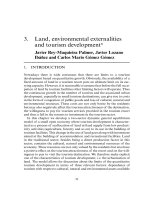THE ECONOMICS OF MONEY,BANKING, AND FINANCIAL MARKETS 488
Bạn đang xem bản rút gọn của tài liệu. Xem và tải ngay bản đầy đủ của tài liệu tại đây (44.78 KB, 1 trang )
456
PA R T V
Central Banking and the Conduct of Monetary Policy
INSIDE THE CENTRAL BANK
Emergency Lending Assistance to Troubled Banks
Canadian Commercial and Northland. In
1985, there was public concern over the quality
of the assets of two small Alberta-based banks
the Canadian Commercial Bank and the Northland
Bank which had made many bad loans. Larger
depositors, whose accounts exceeded the $60 000
limit insured (at that time) by the CDIC, began
to withdraw their deposits, and the failure of
the banks was imminent. Because the immediate
failure of Canadian Commercial and Northland
would have had repercussions on other vulnerable banks, the Bank of Canada, under the
advice from the Inspector General of Banks (the
predecessor of the Office of the Superintendent
of Financial Institutions Canada) made extraordinary advances. Total emergency lending assistance amounted to $1.8 billion so that depositors,
including the largest, would not suffer any losses.
In doing this, the Bank of Canada was following the precedent established in 1984 by the
Federal Reserve s rescue of Continental Illinois
National Bank. Continental Illinois had made
bad loans (primarily to businesses in the energy
industry and to foreign countries), and rumours of
financial trouble in early May 1984 caused large
depositors to withdraw over US$10 billion of deposits
from the bank. The Federal Deposit Insurance
Corporation (FDIC) arranged a rescue effort in
July 1984 that culminated in a US$4.5 billion commitment of funds to save the bank. Still the Fed had
to lend Continental Illinois over US$5 billion
making the Bank of Canada s $1.8 billion advances
to Canadian Commercial and Northland look like
small potatoes! Although Continental Illinois was
taken over by the FDIC, the Fed s action prevented
further bank failures, and a potential bank panic
was averted.
The Bank of Canada, however, was not as
successful in preventing a bank crisis. With the
failure of Canadian Commercial and Northland,
rumours of financial trouble caused many
large depositors to withdraw large deposits from
the Bank of British Columbia, Mercantile Bank,
and Continental Bank. By the time Mercantile
was acquired by the National Bank of Canada,
the Bank of British Columbia by the Hongkong
Bank of Canada, and Continental by Lloyds
Bank of Canada, the Bank of Canada had provided emergency lending assistance of more
than $5 billion (see Figure 17-11). The loss of
public confidence in the Canadian banking system led to the financial reforms of 1987 1992
and the consolidating of financial institution
supervision under the Office of the Superintendent of Financial Institutions Canada.
Term PRAs are similar to special PRAs (see Figure 17-6), but have a
term longer than one business day, typically a term of 28 business days. They are
offered to primary dealers and used at times of crisis, when asymmetric information among market participants impairs their ability to buy and sell an asset class
or maturity, thereby distorting liquidity premiums in the money market.
For example, against the backdrop of widening spreads and increased volatility in the term interbank market in the second half of 2008, the Bank of Canada
announced that it would enter into a series of 28-day PRA transactions, thereby
injecting huge amounts of liquidity into the markets. Moreover, the Bank
expanded its list of acceptable collateral to include bank-sponsored asset-backed
commercial paper and U.S. Treasuries. It also expanded its list of eligible counterparties. In engaging in these trades, the Bank takes securities onto its books in
exchange for borrowings from the Bank s standing lending facility.
TERM PRAS









